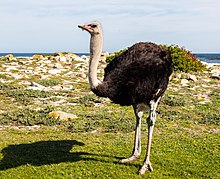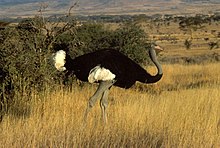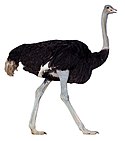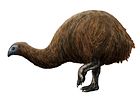Struthionidae
| Struthionidae | |
|---|---|

| |
| Struthio camelus australis at the Cape of Good Hope, South Africa | |
| Scientific classification | |
| Domain: | Eukaryota |
| Kingdom: | Animalia |
| Phylum: | Chordata |
| Class: | Aves |
| Infraclass: | Palaeognathae |
| Order: | Struthioniformes Latham, 1790 |
| Family: | Struthionidae Vigors, 1825[1] |
| Type genus | |
| Struthio Linnaeus, 1758
| |
| Genera | |
| Synonyms[2] | |
| |
Struthionidae (/ˌstruːθiˈɒnədiː/; from Latin strūthiō 'ostrich' and Ancient Greek εἶδος (eîdos) 'appearance, resemblance') is a family of flightless birds, containing the extant ostriches and their extinct relatives. The two extant species of ostrich are the common ostrich and Somali ostrich, both in the genus Struthio, which also contains several species known from Holocene fossils such as the Asian ostrich. The common ostrich is the more widespread of the two living species, and is the largest living bird species. The extinct genus Pachystruthio from the Late Pliocene-Early Pleistocene of Eurasia is one of the largest birds ever.[3]
The first species of Struthio appear during the Miocene epoch, though various Paleocene, Eocene, and Oligocene fossils may also belong to the family.[4][5] Ostriches are classified in the ratite group of birds, all extant species of which are flightless, including the kiwis, emus, and rheas. Traditionally, the order Struthioniformes contained all the ratites. However, recent genetic analysis has found that the group is not monophyletic, as it is paraphyletic with respect to the tinamous, so the ostriches are usually classified as the only members of the order,[6][7] though the IUCN uses a broader classification and includes all "ratites" and tinamous in Struthioniformes.[8]
Evolution
[edit]Struthionidae is a member of the Struthioniformes, a group of paleognath birds which first appeared during the Early Eocene, and includes a variety of flightless forms which were present across the Northern Hemisphere (Europe, Asia and North America) during the Eocene epoch. The closest relatives of Struthionidae within the Struthioniformes are the Ergilornithidae, known from the late Eocene to early Pliocene of Asia. It is therefore most likely that Struthionidae originated in Asia.[9] The oldest records of Struthionidae, belonging to the genus Struthio, are from the Early Miocene of Africa, around 21 million years old. Struthio dispersed into and became widespread in Eurasia during the late middle-Late Miocene epoch beginning around 12 million years ago. Pachystruthio from the Late Pliocene of Eurasia contains some of the largest bird species ever with some species likely weighing up to 450 kilograms (990 lb).[10]

While the relationship of the African fossil species is comparatively straightforward, many Asian species of ostriches have been described from fragmentary remains, and their interrelationships and how they relate to the African ostriches are confusing. In China, ostriches are known to have become extinct only around or even after the end of the last ice age; images of ostriches have been found there on prehistoric pottery and petroglyphs.[11][12][13]
Distribution and habitat
[edit]
Today ostriches are only found natively in the wild in Africa, where they occur in a range of open arid and semi-arid habitats such as savannas and the Sahel, both north and south of the equatorial forest zone.[14] The Somali ostrich occurs in the Horn of Africa, having evolved isolated from the common ostrich by the geographic barrier of the East African Rift. In some areas, the common ostrich's Masai subspecies occurs alongside the Somali ostrich, but they are kept from interbreeding by behavioral and ecological differences.[15] The Arabian ostriches in Asia Minor and Arabia were hunted to extinction by the middle of the 20th century, and in Israel attempts to introduce North African ostriches to fill their ecological role have failed.[16] Escaped common ostriches in Australia have established feral populations.[17]
Taxonomy
[edit]
In 2019, the species S. pannonicus, S. dmanisensis (the giant ostrich), and S. transcaucasicus were transferred to the genus Pachystruthio.[18]
Order Struthioniformes Latham 1790 (ostriches)
- Family Struthionidae Vigors 1825
- Genus †Pachystruthio (Kretzoi 1954) (Late Pliocene – Pleistocene)
- Genus Struthio Linnaeus 1758 (Early Miocene – Recent)
See also
[edit]References
[edit]- ^ Vigors, Nicholas Aylward (1825). "Observations on the natural affinities that connect the orders and families of birds". Transactions of the Linnean Society of London. 14 (3): 395-517 [483].
- ^ Mlíkovský, Jiří (2002). Cenozoic birds of the world Part 1 : Europe (PDF). Praha: Ninox Press. p. 60. ISBN 80-901105-3-8.
{{cite book}}: CS1 maint: ignored ISBN errors (link) - ^ Zelenkov, N. V.; Lavrov, A. V.; Startsev, D. B.; Vislobokova, I. A.; Lopatin, A. V. (2019). "A giant early Pleistocene bird from eastern Europe: unexpected component of terrestrial faunas at the time of early Homo arrival". Journal of Vertebrate Paleontology. 39 (2): e1605521. Bibcode:2019JVPal..39E5521Z. doi:10.1080/02724634.2019.1605521. S2CID 198384367.
- ^ Buffetaut, E.; Angst, D. (November 2014). "Stratigraphic distribution of large flightless birds in the Palaeogene of Europe and its palaeobiological and palaeogeographical implications". Earth-Science Reviews. 138: 394–408. doi:10.1016/j.earscirev.2014.07.001.
- ^ Agnolin et al, Unexpected diversity of ratites (Aves, Palaeognathae) in the early Cenozoic of South America: palaeobiogeographical implications Article in Alcheringa An Australasian Journal of Palaeontology · July 2016 DOI: 10.1080/03115518.2016.1184898
- ^ Hackett, S.J. et al. (2008) A Phylogenomic Study of Birds Reveals Their Evolutionary History. Science, 320, 1763.
- ^ Yuri, T. (2013) Parsimony and model-based analyses of indels in avian nuclear genes reveal congruent and incongruent phylogenetic signals. Biology, 2:419–44.
- ^ "The IUCN Red List of Threatened Species". IUCN Red List of Threatened Species. Retrieved 2020-04-10.
- ^ Mayr, Gerald; Zelenkov, Nikita (2021-11-13). "Extinct crane-like birds (Eogruidae and Ergilornithidae) from the Cenozoic of Central Asia are indeed ostrich precursors". Ornithology. 138 (4): ukab048. doi:10.1093/ornithology/ukab048. ISSN 0004-8038.
- ^ Widrig, Klara; Field, Daniel J. (February 2022). "The Evolution and Fossil Record of Palaeognathous Birds (Neornithes: Palaeognathae)". Diversity. 14 (2): 105. doi:10.3390/d14020105. ISSN 1424-2818.
- ^ Doar, B.G. (2007) "Genitalia, Totems and Painted Pottery: New Ceramic Discoveries in Gansu and Surrounding Areas". China Heritage Quarterly
- ^ Janz, Lisa; et al. (2009). "Dating North Asian surface assemblages with ostrich eggshell: implications for palaeoecology and extirpation". Journal of Archaeological Science. 36 (9): 1982–1989. Bibcode:2009JArSc..36.1982J. doi:10.1016/j.jas.2009.05.012.
- ^ Andersson, J. G. (1923). "Essays on the cenozoic of northern China". Memoirs of the Geological Survey of China (Peking), Series A. 3: 1–152 (53–77).
- ^ Donegan, Keenan (2002). "Struthio camelus". Animal Diversity Web. University of Michigan Museum of Zoology.
- ^ Freitag, Stephanie & Robinson, Terence J. (1993). "Phylogeographic patterns in mitochondrial DNA of the Ostrich (Struthio camelus)" (PDF). The Auk. 110 (3): 614–622. doi:10.2307/4088425. JSTOR 4088425.
- ^ Rinat, Zafrir (25 December 2007). "The Bitter Fate of Ostriches in the Wild". Haaretz. Tel Aviv. Retrieved 10 January 2017.
- ^ Ostriches in Australia – and near my home. trevorsbirding.com (13 September 2007)
- ^ Zelenkov, N. V.; Lavrov, A. V.; Startsev, D. B.; Vislobokova, I. A.; Lopatin, A. V. (2019). "A giant early Pleistocene bird from eastern Europe: unexpected component of terrestrial faunas at the time of early Homo arrival". Journal of Vertebrate Paleontology. 39 (2): e1605521. Bibcode:2019JVPal..39E5521Z. doi:10.1080/02724634.2019.1605521. S2CID 198384367.



